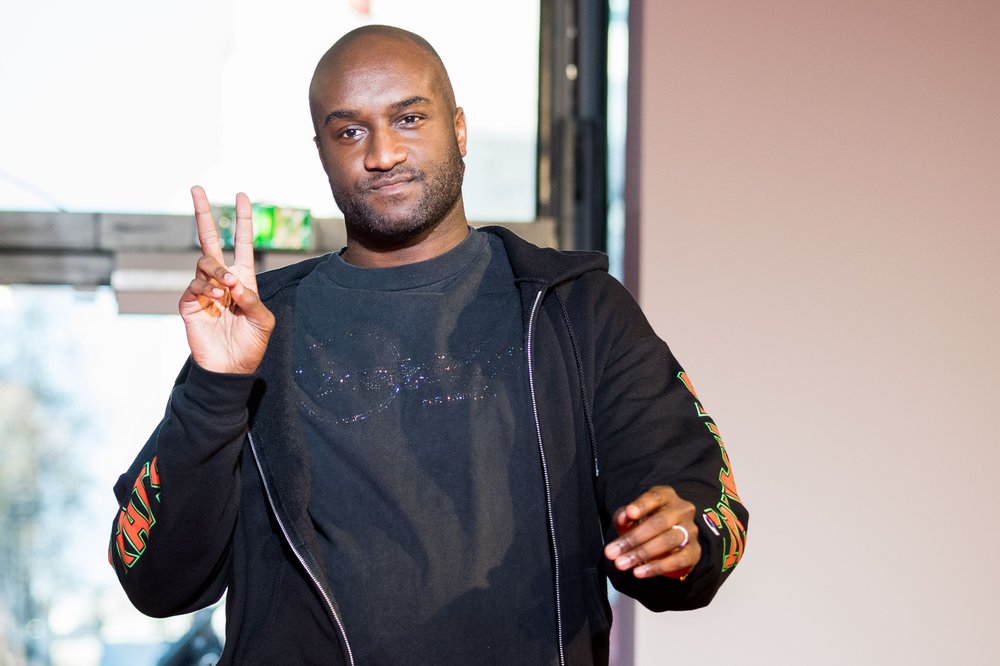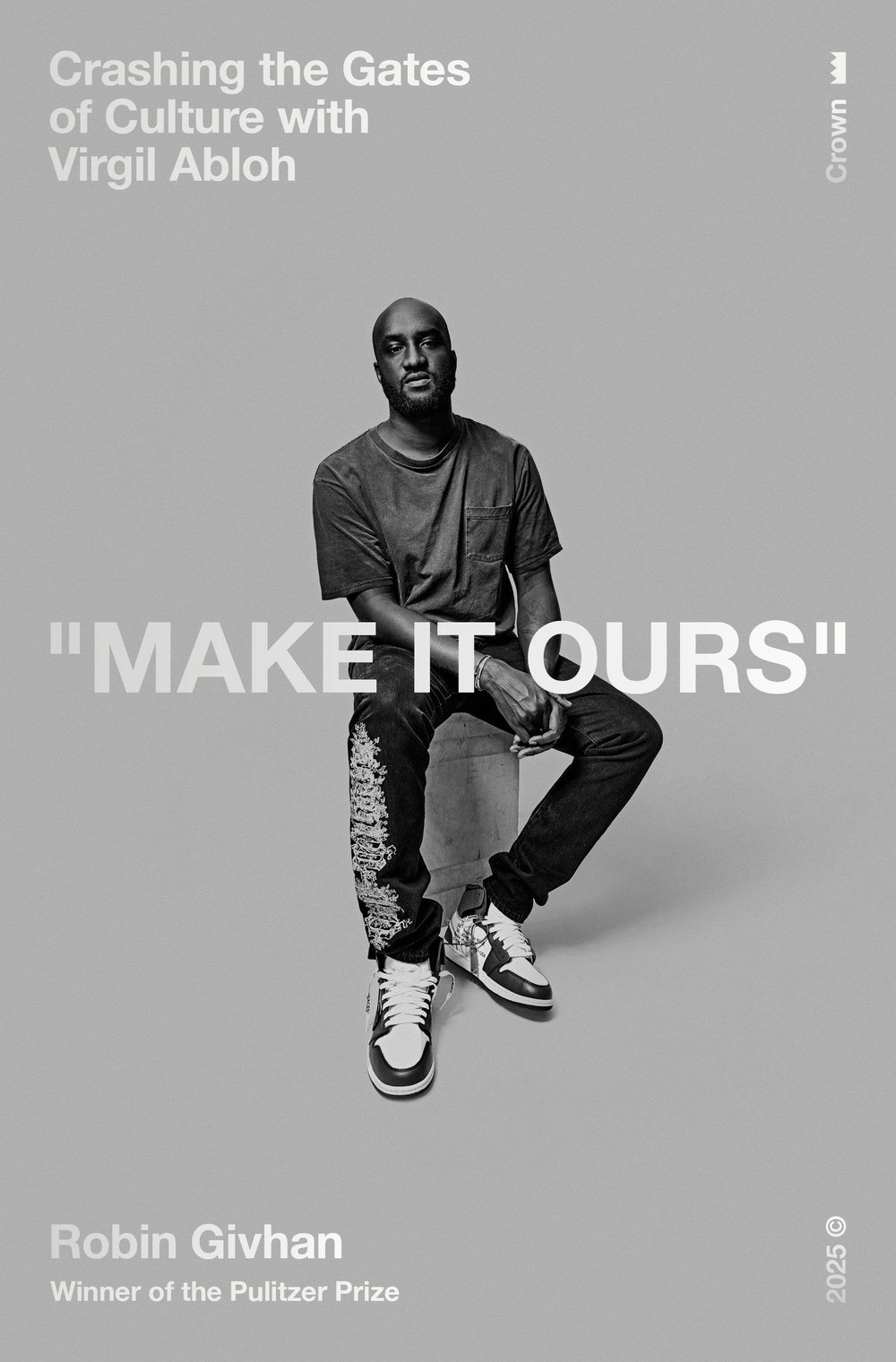A new book looks at Virgil Abloh’s remarkable rise to fame in fashion
July 19, 2025, 8:01 a.m.
“Make It Ours” is the latest book from Pulitzer Prize-winning critic Robin Givhan.

In 2021, the fashion world mourned Virgil Abloh, Louis Vuitton's artistic director of menswear, after he died of a rare form of cancer at just 41 years old.
Now, a new biography by Pulitzer Prize-winning critic Robin Givhan revisits Abloh’s remarkable rise to fame. Abloh, who was born to Ghanaian parents and raised in Rockford, Illinois, studied architecture and worked for Kanye West before founding his brand, Off-White.
“Make It Ours: Crashing the Gates of Culture with Virgil Abloh” reflects on the qualities that propelled him: talent, strong communication skills, a penchant for social media marketing and a unique theory on what made something fashionable.
Givhan talked to WNYC’s Alison Stewart on a recent episode of “All of It.” Below is an edited version of their conversation.
Alison Stewart: You spent a lot of time in your book discussing Rockford, Illinois, which is where he grew up. Why?
Robin Givhan: Virgil talked a lot about doing things to impress the 17-year-old version of himself. He spent a lot of time celebrating 17-year-olds, teenagers, young people, and expressing how he valued their point of view. He valued their sense of style, so I knew that any biography that tried to explore his fashion origins really needed to start with the 17-year-old Virgil.

When he was 17 years old, he was living in Rockford, going to a Catholic high school. Rockford is 90 miles outside of Chicago. It is equidistant between Chicago and the Iowa border, and it's very close to Wisconsin, so it is very Midwestern. It's an industrial city. It is small.
You can very quickly go from modest, Rust Belt-era downtown to cornfields, and I think it’s important that people understood that this was someone who came to fashion from a real dreamer's perspective, not someone who had been able to see all the big designers, right there, just down the street.
I think it was important also to understand that, in many ways, Rockford was segregated. It struggled with segregation in its school system, even in the 1990s. And that in his desire to go to this Catholic high school, which he had asked his parents if he could attend, that he was very much a minority within a minority there.
All of those things were really important in shaping the way that he saw himself in relationship to the fashion industry and the way that he saw himself as someone who spent a lot of time living in the in-between spaces, and that you could flourish in those spaces.
It's interesting how Catholic school helped shape his aesthetic.
Yes, he didn't have to wear a uniform, but had to come to class in a shirt and tie, and I was struck by the way the president of the school describes some of the fundamentals that they taught there, far outside of the basic subjects.
She said that they wanted their students to have the “soft skills” of life, and by that she meant the ability to walk into a room with adults and equip themselves well to know how to engage people, to come in with the firm handshake and to send the follow-up note and to send flowers if necessary, to be charming, for lack of a better word.
Down the line, a lot of people talked about Virgil's incredible emotional IQ and his ability to engage with people, to be so likable in an industry where that can sometimes be challenging, and to just be able to be the person that people wanted to work with.
Did his parents believe in that version of education, or were they about the capital E education, as immigrants?
They were very much about the capital E education. That is one of the reasons why Virgil studied engineering in college. He said, "My parents gave up a lot. They came to this country. They wanted an engineer for a son. The least I could do was give them an engineer."
In studying architecture, did it seem that his mind was on designing not just buildings, but something else?
He described the decision to study architecture as, it was the bridge between something that felt very analytical, the engineering, and his interests in things that were creative.
When he started at the Illinois Institute of Technology for Architecture, he didn't want to be an architect, but he was really interested in the thought process of architects and what it meant to be able to explore the idea that design could impact economics. It could impact civic life. It could impact the aesthetics of an entire community.
When does fashion enter the picture for Virgil Abloh?
It was always bubbling underneath the surface, right? When he was a teenager, he was into the skatewear brands, fascinated by the big designer brands, particularly Vuitton. Early on, he talks about saving up his pennies and buying this little keychain pouch from Vuitton, the least expensive thing that the brand sold that he could afford, but it really enters the picture when he is in architecture school, and he starts silk-screening T-shirts.
The fascination grows through his relationship with Kanye West, who was desperate to start his own fashion line, and at a certain point, Virgil, who's working with him and becomes his creative director, traveling 300 days a year, says to himself, "What am I building for me?"
He begins by creating this art project, he called it, that was called “Pyrex Vision,” and he essentially bought deadstock Ralph Lauren rugby shirts and silk-screened them with the words "Pyrex 23."
He bought these shirts for about $30, $40 a piece; he sold them for well over $500, and they sold out. I think that tells you a lot about the fashion industry, and it was also just the audacity of Virgil believing that by adding his personal mark to these Ralph Lauren shirts that he increased their value, that the sum of these two things was far more valuable than one of them alone.
Happening tangentially to this is the fashion industry turning their attention to Gen X, to hip-hop and the NBA, which was fascinating. Would you explain that a little bit?
Yes. It was so much fun for me to go back and realize how all of these discrete dots were connected. The NBA had an image problem, it felt, and a lot of its young players were entranced by early hip-hop culture and, in particular, the gangster look, and they'd also been plagued by some violent incidents, particularly one that happened at the Palace of Auburn Hills, in Detroit, or outside of Detroit.
They instituted this dress code that banned all of the markings of hip-hop from their wardrobe when they were on team business, but not on the court. Initially, they really balked at these rules. What happened is, the entryways to these stadiums became these runways for athletes, and they leaned into fashion in a huge way. They realized they could use fashion – or at least their advisors and publicists realized that they could use fashion – to build an image off the court, separate from basketball.
They realized it could be a launching pad for their own brands, so you have, all of a sudden, these mostly Black players who become these fashion icons who are appearing on the covers of magazines, who are sitting in the front rows of fashion shows, and everything gets more enhanced because menswear itself starts to have this huge impact on fashion with athleisure wear and with the blurring of gender, and then you have this massive impact on fashion, and you have Black men, who are, in fact, leading the charge. I think that really opened up a world that was ready to have a Black man stand at the top of the fashion world and dictate trends.
Virgil Abloh had an interesting thing he called the 3% rule. Would you explain that?
Virgil would often say that if you changed a pre-existing object by 3%, you had in fact created something new, and he loved tinkering with pre-existing objects' ideas. He loved collaborating with companies and riffing on product. Now, I think any copyright lawyer listening would argue that that is really not an actual folk principle, and Virgil was sued, and he received plenty of cease-and-desist orders.
He was also very diligent about copyrighting his own work, but he would say that as a way of introducing this idea of do-it-yourself creativity, that you didn't have to think about creativity as something that was really distant and formalized and required permission structure in order to engage with, that you could change things and make them your own, and that you should then take that seriously and take your creativity seriously.
I think it was both something that he used proactively, but it was also a bit of a defensive mechanism, too, because he didn't have formal fashion design training. He didn't have formal training in pattern-making, so being able to say that he was a creative person who was playing with these pre-existing ideas also took the pressure off of people looking at his work and saying, "Oh, well, that looks a little derivative," or "I've seen that before." I think he was able to have it both ways.
If you had to think of one reason – there are many – why he was appointed artistic director at Louis Vuitton, what do you think the main reason was?
I think Vuitton understood that it was a brand that really stood on popular culture. It was not a brand that was deeply rooted in ready-to-wear. Even though it had a history of ready-to-wear, it was a recent history, but there's no garment in the Vuitton vocabulary that people immediately think of when they think of Vuitton. You think of a bag. You think of the logo.
In moving forward and in wanting to get the attention of an increasingly diverse customer base, a younger customer base, it looked to culture, people who were exciting the culture for its next designer, and I think that was one of the big reasons why it looked at Virgil. The light was really shining on Virgil because he had just done an incredibly successful and influential collaboration with Nike. When a product at Nike excites people, it excites them in a very loud way, and people notice.
A new documentary looks at Supreme and the rise of NYC’s skateboarding scene The hottest party in New York right now? Labubu raves.